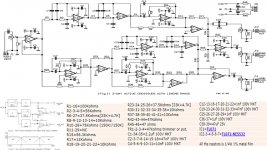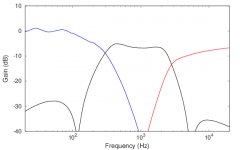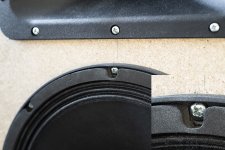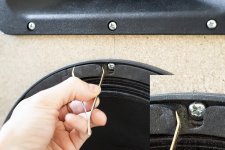You could implement an active filter using a fully analog circuit. That would be a bit of work though, and I am not sure it would be cheaper the
than the normal OSMC passive xover.
Anyway, the OSMC idea is to keep things simple enough for novice builders, and to work well with flea-power amps. The active filter + multi amplifier approach is very different.
than the normal OSMC passive xover.
Anyway, the OSMC idea is to keep things simple enough for novice builders, and to work well with flea-power amps. The active filter + multi amplifier approach is very different.
Yes, active analog xover would be possible and not all that hard to simulate, given its possible to do a passive xover with all the phase shifts and reactive loads you have to deal with.
The Volt VM752 midrange drivers are available by special order only with a wait time of 8 to 10 weeks. Solen doesn't stock them right now. Falcon can order them.
The Volt VM752 midrange drivers are available by special order only with a wait time of 8 to 10 weeks. Solen doesn't stock them right now. Falcon can order them.
The Volt VM752 midrange drivers are available by special order only with a wait time of 8 to 10 weeks. Solen doesn't stock them right now. Falcon can order them.
That is quite normal. You could also ask Volt directly.
Looking at power response i was wondering - aren't you just a little bit worried about that hump from 700Hz-1300Hz ? Have you tried to linearize it and have a listen for subjective differences ?
My thoughts on this back then were the following:
I did try to reduce the SPL a bit in the 1 kHz range. My ears preferred it the way it is. I guess it all boils down to how we perceive the sound, and how this relates to the measurements and diagrams. Sometimes speakers sound better if we don't completely remove the acoustic imperfections from the measurement results.
During development of the xover filter using the DSP filters, I did linearize the little hump that ZVU mentioned, and I didn't like it that much. But later on I also learned that the DSPs didn't sound that good in general, while the passive filters sounded much nicer, although they measured the same. So... what if there was something that I missed during the DSP filter work? What if things could be improved further?
This morning I was bored, so I decided to pay some attention to those thoughts lingering around the backyard of my brain. Playing around with VituixCAD I found that changing the value of the 0.33 mH inductor in the midrange filter should help to flatten the little hump in the power response, without causing other trouble. I tried some inductors I found in the parts box and I have been listening with 0.47 mH for an hour or two now.
I like what I hear so far. It's not a day-or-night difference, but I feel like it's a good tweak. I will listen to this a bit longer to see how it does in the longer term. If someone else would like to give it a try, it would be interesting to read their opinion!
I'm always game for tweaking. This is the huge benefit to having external x-overs!
These?:
Coil Mundorf M-Coil BV Air-core BL100 0.47 mH 1.0 mm - Fidelity Components Shop
I'd also pick up some resistors to play with the tweeter tweak you mentioned and also grab a pair of bass ports to experiment with...
For education—how might flattening "the hump" equate to something audible?
These?:
Coil Mundorf M-Coil BV Air-core BL100 0.47 mH 1.0 mm - Fidelity Components Shop
I'd also pick up some resistors to play with the tweeter tweak you mentioned and also grab a pair of bass ports to experiment with...
For education—how might flattening "the hump" equate to something audible?
You could implement an active filter using a fully analog circuit.
eBay has a few low cost (~$60) opamp-based 2-way and 3-way analog filters which use low power resistors to set crossover frequencies.
Attachments
LXmini Crossover / Analog Crossover Network – diyAudio Store
For a future fun-path—could even put the adjustments on front panel knobs. BUT. Building the x-overs as designed are A. Super fun, B. Not really complicated, C. Look beautiful., D. Work excellent.
For a future fun-path—could even put the adjustments on front panel knobs. BUT. Building the x-overs as designed are A. Super fun, B. Not really complicated, C. Look beautiful., D. Work excellent.
Last edited:
eBay has a few low cost (~$60) opamp-based 2-way and 3-way analog filters which use low power resistors to set crossover frequencies.
Forget it. I would be very surprised if these circuits could do the filter transfer functions needed for the Monkey Coffin (see attachment).
Attachments
Hats off to the guys in Estonia at audiohobby.eu. Parts already shipped. UPS 3 day, $33 (shipping is free over a certain amount) to the US...
As you all work with the same woofer I use have question: Faital states SD of 539 sq cm for 12PR320, but loutspeakerdatabase writes it is 489 and this is also the number I entered in WinISD and it will be calculated if left out as the very same. The diameter between the edge of the suspension is only 24 cm (453 sq cm) plus the suspension is also emitting some sound, which makes 490 sq cm more plausible. Has someone a reliable number on this? It actually makes a difference in some regard.
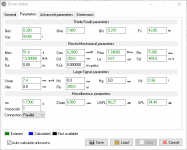
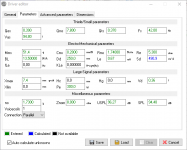


half the suspension added to cone surcafe is the correct rule for SD? And the dustcap is added in total as emitting surface too?
As far as I can tell there is no good reason to do it differently...
I you want to dig deeper, you might continue the discussion here.
I should have written hat I took an estimation of the surround deformation into account. I did not dig out that math, it would be a function of surround form, typical mass, elastic properties and loss factors of the surround material and speed and excursion of the cone.
So effectively the Sd contribution of the surround would be big at low levels and low frequencies, but lower at high ones. Taking 0.5 is good enough, but it’s first order approach of a rather complex issue. And 0.3 is likely closer to the truth in real life, I think.
So effectively the Sd contribution of the surround would be big at low levels and low frequencies, but lower at high ones. Taking 0.5 is good enough, but it’s first order approach of a rather complex issue. And 0.3 is likely closer to the truth in real life, I think.
The foam front gasket is glued to a paper ring that sits ontop of the cone. It looks as if it separates quite easily, check this with your own driver. At the cutouts for the screws, if you apply some pressure to one of the round corners, the foam already begins to lift a little from the paperbase. Probably, with some patience it is removed within a couple of minutes without any damage to the cone suspension.You're right. I've just inspected mine. Foam indeed.
View attachment 922690
This makes things much easier. Very sharp scalpel and leveling jig.
The foam front gasket is glued to a paper ring that sits ontop of the cone.
Is the paper ring just the extension of the cone, or is it a separate part?
- Home
- Loudspeakers
- Multi-Way
- Open Source Monkey Box
